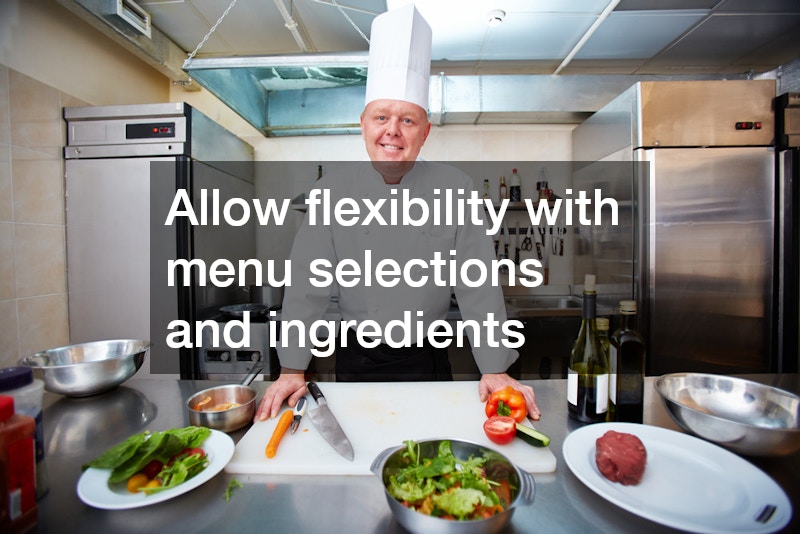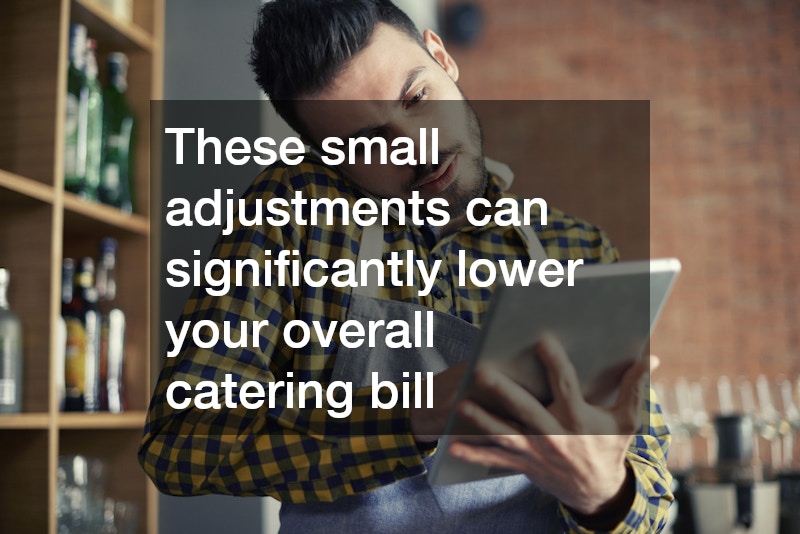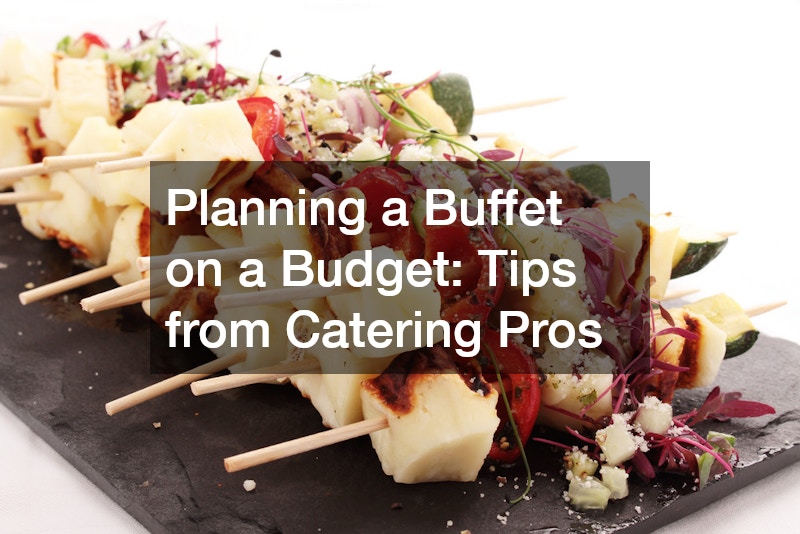Disclaimer: The Lifestyle Elf. This site provides fashion and lifestyle content for informational purposes only.
-
Buffet catering is cost-effective because it requires fewer staff, offers flexible portions, and allows you to serve a variety of affordable dishes in bulk.
-
Collaborate closely with your catering company by clearly communicating your budget, being flexible with ingredients, and asking about cost-saving package options.
-
Simplify the menu to include just 2 proteins, 2–3 sides, and 1–2 desserts—this reduces waste and focuses quality on fewer, well-executed items.
-
Choose a serving style that matches your budget, such as self-serve or drop-off buffet service, to significantly reduce staffing and equipment costs.
-
Use presentation to create impact without spending more, like tiered displays, greenery, DIY signage, and compostable servingware.
-
Save on desserts and drinks by handling them yourself, offering bulk beverage stations, or opting for a single sheet cake or signature cocktail.

How to partner with the right catering company to serve a stunning buffet without overspending
Planning a catered buffet can be an excellent way to offer your guests variety, flexibility, and comfort. Buffets are perfect for weddings, birthday celebrations, anniversaries, company functions, and community events because they allow attendees to choose what they want, in the portion size that suits them. However, many hosts worry about the potential cost of working with a professional catering company—especially when the goal is to keep expenses under control. The good news? With strategic planning and expert guidance, you can organize a delicious, crowd-pleasing buffet that doesn’t stretch your wallet. Below, we’ve compiled comprehensive, expert-backed advice from seasoned professionals in the event catering business. These practical insights will help you make informed decisions, reduce unnecessary expenses, and still create an unforgettable dining experience.
Why Buffets Offer Better Value Than Plated Meals
A buffet setup can significantly reduce your catering bill while offering a rich selection of food options. Most full-service caterers offer buffet packages that cost less per guest than formal plated service. The savings come from reduced staffing needs, simpler serving logistics, and the ability to control portions more easily. Buffet meals also minimize food waste, as guests are more likely to take what they know they can eat. Additionally, buffets can accommodate different dietary preferences more efficiently than a fixed menu, which can eliminate the need for special dishes. From a service standpoint, buffets streamline mealtime and reduce wait times since everyone can be served simultaneously. The overall result is an experience that feels abundant and satisfying without incurring the additional labor costs associated with formal dining.
Core advantages of choosing a buffet catering company:
- Lower labor costs due to fewer required service staff
- Flexible portion sizes that reduce food waste
- Easier bulk preparation and cost-effective menu scaling
- Broader variety of dishes at lower per-head costs
- Accommodation of dietary preferences without complex logistics
Common budget pitfalls to avoid:
- Over-ordering food out of fear of running out
- Choosing expensive proteins like steak or seafood for all entrees
- Renting unnecessary or high-end buffet equipment
- Paying for extra décor elements not included in basic packages
Work Collaboratively with Your Catering Company
To maximize your budget, it’s crucial to establish a collaborative relationship with your buffet catering provider from the beginning. Many people approach caterers with rigid expectations or incomplete information, which can lead to costly misunderstandings. Instead, come prepared with your estimated headcount, event details, and a clear budget range. This gives your caterer the tools they need to recommend affordable, tailored solutions. Experienced caterers often know how to stretch ingredients, substitute costly items with more economical options, and simplify logistics to save time and money. Trusting their expertise and giving them room to make suggestions can open up opportunities you hadn’t considered. Don’t hesitate to ask what items are in season, what dishes can be made in bulk, or whether scaled-back service might meet your needs.
Smart ways to work with a catering company:
- Share your guest count and total budget up front
- Allow flexibility with menu selections and ingredients
- Request pre-designed value packages or bulk meal deals
- Schedule a tasting or phone consultation to explore cost-saving ideas
- Discuss scaled-back service options for informal or smaller events
Questions to ask your caterer:
- “What affordable buffet options do you currently offer?”
- “Can you suggest any seasonal or lower-cost ingredients?”
- “Is there a savings difference between drop-off and full-service catering?”
- “What equipment or setup do you include in your packages?”
Simplify the Menu Without Sacrificing Quality
Creating a buffet that impresses doesn’t require an elaborate or oversized menu. In fact, a well-edited selection of thoughtfully prepared dishes can be just as memorable as a spread with dozens of options. Focus on balance and guest satisfaction, rather than sheer volume. Limit your menu to a couple of proteins, a few sides, and one or two salads and desserts. This approach not only saves money but also reduces complexity for the kitchen and serving staff. Concentrating your resources on fewer dishes allows the catering company to elevate the quality, flavor, and presentation of each item. Additionally, smaller menus minimize the likelihood of food waste, which is another way to stay under budget while being environmentally responsible.
Recommended buffet menu structure:
- Two proteins: one meat-based (e.g., grilled chicken), one vegetarian (e.g., pasta primavera)
- Two to three sides: roasted vegetables, mashed potatoes, rice pilaf
- One to two salads: Caesar salad, couscous salad with herbs
- One dessert: brownies, sheet cake, or fruit tart
High-impact, low-cost buffet items:
- Pasta dishes like baked ziti or penne Alfredo
- Grain sides such as wild rice or couscous
- Affordable proteins like chicken thighs or pulled pork
- Vegetarian options like lentil curry or roasted chickpea salad
- Steamed or roasted seasonal vegetables for color and variety
Choose a Buffet Style That Matches Your Budget
Not all buffet styles are created equal, and understanding the different service models can help you control costs. The most cost-effective option is often a drop-off buffet, where the caterer prepares the food off-site and delivers it ready to serve. This eliminates labor costs associated with on-site cooking or serving. A traditional self-serve buffet is also economical, especially when the host or a minimal staff handles refills. Full-service buffets, where staff are present to serve food and manage the flow, are more expensive due to additional labor. Your catering company can help you weigh the pros and cons of each model based on your event’s formality and size. Also, don’t overlook the cost of rentals and setup, as these can add up quickly.
Buffet service styles ranked by cost:
- Drop-off buffet (least expensive)
- Self-serve buffet with limited staff
- Staffed buffet with attendants for portion control
- On-site live stations or chef-attended carving areas (most expensive)
Additional savings tips:
- Choose compostable plates and utensils instead of renting tableware
- Limit hot items that require chafing dishes and fuel
- Use cold items like pasta salad and charcuterie boards to reduce equipment needs
- Consolidate setup with a single buffet line to save space and labor
Use Strategic Presentation to Elevate the Experience
Even on a modest budget, your buffet can look upscale and intentional with a few creative presentation techniques. The key is to use height, color, and layout to your advantage. Tiered trays, risers, and natural elements like fresh herbs or fruit can make a buffet table feel bountiful without requiring additional food. Clean, coordinated serving dishes and thoughtful signage also contribute to a polished look. Your catering provider may offer basic display items at no extra charge, so ask what’s included in their setup. Investing in visual presentation not only enhances the guest experience but also gives your buffet a premium feel without premium costs.
Affordable buffet display ideas:
- Use crates, boxes, or risers to create vertical interest
- Incorporate fresh herbs, lemon slices, or edible flowers for decoration
- Print custom menu cards or chalkboard signs for dish labeling
- Use simple linens or table runners in your event colors
- Add LED candles or fairy lights to enhance evening ambiance
Save on Desserts and Drinks Without Diminishing the Experience
Desserts and beverages can be surprisingly costly when sourced from a full-service catering company, but there are ways to trim these expenses without disappointing your guests. Many hosts opt to provide their own desserts, such as sheet cakes, cookie trays, or cupcakes from a local bakery. Similarly, self-serve drink stations with lemonade, iced tea, or fruit-infused water can replace more expensive bottled beverages or staffed bars. If alcohol is part of your event, consider offering a signature drink instead of a full open bar. These small adjustments can significantly lower your overall catering bill while still providing guests with thoughtful and enjoyable options.
Budget-friendly dessert options:
- Sheet cake with decorative toppings
- Mini cupcakes or brownie bites
- Fruit skewers or parfaits with seasonal berries
- Ice cream or sorbet cups for warm-weather events
Drink station ideas:
- Lemonade or iced tea in beverage dispensers
- Fruit-infused water (citrus, cucumber, mint)
- Bulk coffee and tea service with simple condiments
- One signature cocktail served from a dispenser or punch bowl

Advanced Budget-Saving Tactics from Industry Pros
Seasoned catering professionals often have a few extra tricks up their sleeves for helping clients save money. Booking early is a common strategy, as prices can increase closer to peak seasons or holidays. Hosting your event on a weekday or during daytime hours can also lead to lower rates, since demand is generally lower than for weekend evenings. Another tip is to allow your caterer to choose certain dishes based on what ingredients they can source affordably at the time. These “chef’s choice” offerings often reduce food costs while maintaining high quality. If you’re hosting a private event, reducing your guest list by just a few people can also make a big difference, especially when pricing is calculated per person.
Proven ways to keep catering costs low:
- Book your catering company well in advance to secure lower rates
- Choose an off-peak time or day for your event
- Allow flexibility in the menu with chef’s choice items
- Consolidate food and rental services under one vendor
- Ask about leftover policies to extend the value of your meal
Sample Budget: Buffet for 60 Guests
Here’s a practical breakdown of a mid-size buffet planned in collaboration with a local caterer:
| Item | Estimated Cost |
|---|---|
| Buffet menu (entree + 2 sides) | $17 per person x 60 = $1,020 |
| Drop-off delivery + setup | $100 |
| Compostable plates/utensils | $0.75 per person = $45 |
| DIY drink station (lemonade/tea) | $35 |
| Sheet cake from local bakery | $60 |
| Table linens + signs | $40 |
| Total | $1,300 |
Final Thoughts: Cater Smart, Spend Less, Impress More
Buffet-style catering can be both affordable and elegant—if you take a strategic, collaborative approach. By choosing a simplified menu, working closely with your cate
ring provider, and prioritizing value-focused service styles, you can create an event that feels luxurious without the high-end price tag. Presentation, smart ingredient choices, and targeted cost-cutting decisions can elevate even a modest buffet into a memorable culinary experience. Remember, successful events aren’t defined by how much you spend, but by how well you meet the needs of your guests within your means. With the right event catering company and a bit of creativity, you can deliver an outstanding buffet experience that delights without draining your budget.

